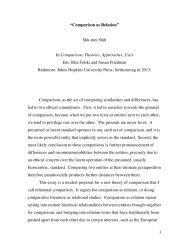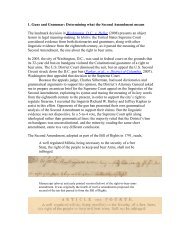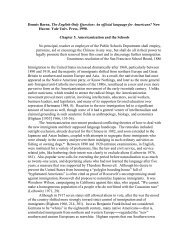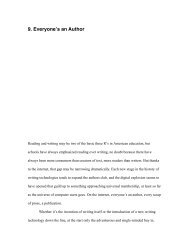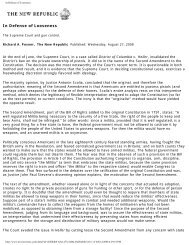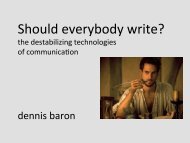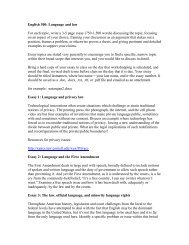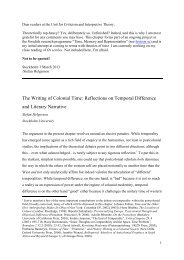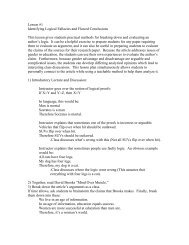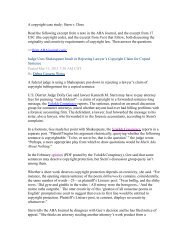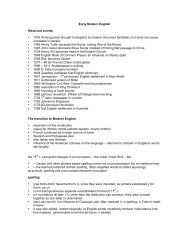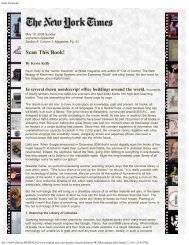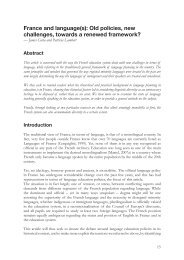It's hard to write a good paper about a bad topic. That's why ... - English
It's hard to write a good paper about a bad topic. That's why ... - English
It's hard to write a good paper about a bad topic. That's why ... - English
You also want an ePaper? Increase the reach of your titles
YUMPU automatically turns print PDFs into web optimized ePapers that Google loves.
Annotated Bibliography Script Rhe<strong>to</strong>ric 105<br />
Rationale:<br />
You should think of using sources by putting them in<strong>to</strong> conversation with each other and<br />
finding your own role in that conversation. This assignment asks you <strong>to</strong> take that<br />
“conversation” metaphor seriously.<br />
Assignment:<br />
Using at least 5 of your 8 sources, create a 2-3 page script of a conversation among the<br />
sources and yourself. That is, <strong>write</strong> a script of the conversation that might take place if<br />
you and all the authors of your sources could be <strong>to</strong>gether in the same room at the same<br />
time. You can <strong>write</strong> whatever you want for your own contributions, but the contributions<br />
from your sources should consist of either direct quotations or paraphrases, which should<br />
be cited parenthetically.<br />
Notes on the Script:<br />
- Be creative. While the default format is a dramatic script (that is, written like<br />
a play), you may choose <strong>to</strong> represent this conversation in any way you like.<br />
- Start by providing a “cast of characters,” a list of participants in this<br />
conversation.<br />
- Briefly describe the imaginary setting for this conversation.<br />
- The majority of the script should be direct quotations from your sources.<br />
- Put quotation marks around everything you are taking directly from a source,<br />
and put the author’s last name and the page number for that quote in<br />
parentheses. If you need <strong>to</strong> add anything <strong>to</strong> the quotes <strong>to</strong> make them “flow”<br />
better, put that stuff in brackets [like this].<br />
- Don’t just make a list of random quotes from sources. Rather, make the<br />
sources “speak or respond <strong>to</strong> each other, or make them respond <strong>to</strong> questions<br />
you might pose <strong>to</strong> them.<br />
- Also, don’t limit yourself <strong>to</strong> presenting quotes from sources that agree with<br />
you. Try <strong>to</strong> represent the range of possible positions concerning your <strong>to</strong>pic.<br />
- Make yourself a character or participant in this conversation. You might<br />
choose <strong>to</strong> mostly ask questions of your sources, or you might take a position<br />
of your own.<br />
- In addition <strong>to</strong> your sources and yourself, you may include “fictional”<br />
composite characters that represent a particular position or way of looking at<br />
your issue. Don’t overuse this function.<br />
Criteria of Evaluation:<br />
- The degree <strong>to</strong> which this collage puts your sources in<strong>to</strong> a genuine<br />
conversation with each other, rather than simply listing quotations from these<br />
sources.<br />
- The degree <strong>to</strong> which you fairly represent a range of possible positions or<br />
points of view on your <strong>to</strong>pic.<br />
- The correctness of the in-text citations (see the Wadsworth Handbook)<br />
Due Date: Monday 4/3



